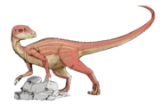
Abrictosaurus
Overview
Abrictosaurus is a genus
of heterodontosaurid
dinosaur
from the Early Jurassic
Period of what is now southern Africa
. It was a small bipedal herbivore
or omnivore
, approximately 1.2 meters (4 feet) long, and weighing less than 45 kilograms (100 pounds).
This dinosaur is known from the fossil
remains of only two individuals, found in the Upper Elliot Formation
of Qacha's Nek District
in Lesotho and Cape Province
in South Africa, respectively.
Genus
In biology, a genus is a low-level taxonomic rank used in the biological classification of living and fossil organisms, which is an example of definition by genus and differentia...
of heterodontosaurid
Heterodontosauridae
Heterodontosauridae is a family of early ornithischian dinosaurs that were likely among the most basal members of the group...
dinosaur
Dinosaur
Dinosaurs are a diverse group of animals of the clade and superorder Dinosauria. They were the dominant terrestrial vertebrates for over 160 million years, from the late Triassic period until the end of the Cretaceous , when the Cretaceous–Paleogene extinction event led to the extinction of...
from the Early Jurassic
Jurassic
The Jurassic is a geologic period and system that extends from about Mya to Mya, that is, from the end of the Triassic to the beginning of the Cretaceous. The Jurassic constitutes the middle period of the Mesozoic era, also known as the age of reptiles. The start of the period is marked by...
Period of what is now southern Africa
Africa
Africa is the world's second largest and second most populous continent, after Asia. At about 30.2 million km² including adjacent islands, it covers 6% of the Earth's total surface area and 20.4% of the total land area...
. It was a small bipedal herbivore
Herbivore
Herbivores are organisms that are anatomically and physiologically adapted to eat plant-based foods. Herbivory is a form of consumption in which an organism principally eats autotrophs such as plants, algae and photosynthesizing bacteria. More generally, organisms that feed on autotrophs in...
or omnivore
Omnivore
Omnivores are species that eat both plants and animals as their primary food source...
, approximately 1.2 meters (4 feet) long, and weighing less than 45 kilograms (100 pounds).
This dinosaur is known from the fossil
Fossil
Fossils are the preserved remains or traces of animals , plants, and other organisms from the remote past...
remains of only two individuals, found in the Upper Elliot Formation
Upper Elliot Formation
The Upper Elliot Formation is a geological formation dating to roughly between 200 to 190 million years ago and covering the Hettangian to Sinemurian stages. The Upper Elliot Formation is found in South Africa and Lesotho and is a member of the Stormberg Group. It consists mainly of limestone,...
of Qacha's Nek District
Qacha's Nek District
Qacha's Nek is a district of Lesotho. It has an area of 2,349 km² and a population in 2006 of approximately 71,876. Qacha's Nek is the capital or camptown, and only town in the district.-Geography:...
in Lesotho and Cape Province
Cape Province
The Province of the Cape of Good Hope was a province in the Union of South Africa and subsequently the Republic of South Africa...
in South Africa, respectively.

